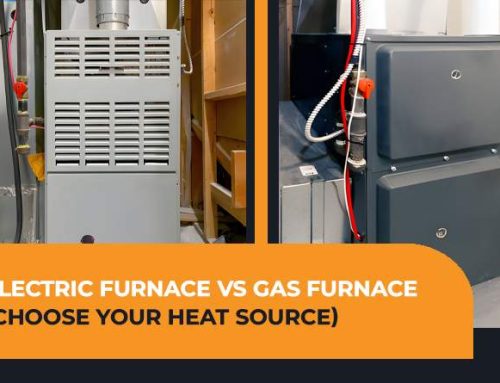Furnaces and air handlers keep our houses warm but serve different purposes. Both contribute to home heating, but the former produces heat while the latter distributes it. Selecting the ideal system for your heating demands might be easier if you know these variations.
If you need clarification about an air handler vs a furnace, let’s break it down.
How Does a Furnace Work?
A furnace is an independent heating device that produces heat to keep your house cozy. Parts of a furnace include the blower fan, thermostat, heat exchanger, and burner. It doesn’t have a cooling feature and heats your house.
1- Fuel Ignition
Most furnaces create heat using natural gas, propane, or electricity. When you adjust the thermostat to raise the temperature in your home, it instructs the furnace to begin functioning. If it’s a gas furnace, a valve opens, allowing gas to enter the burner. Electric coils heat up in electric furnaces.
2- Heat Generation
Heat is produced once the fuel ignites. The heat exchanger is one of the parts that gets warmed by this heat. When the fuel burns, a metal chamber known as the heat exchanger gets heated.
3- Air Circulation
The blower fan, a separate component, starts to operate as the heat exchanger heats up. Through the return ducts in your house, this fan draws air in. The heated heat exchanger is passed over by the air, heating it.
4- Distribution
The blower fan forces hot air back into your house via the ducting. Your home’s temperature rises as the warm air passes through the ducts and emerges from vents in various rooms.
5- Thermostat Regulation
The thermostat detects when the target temperature has been reached and tells the furnace to turn off the heat. The blower fan slows down or shuts off when the furnace stops heating the coils or burning fuel.
How Does an Air Handler Work?
Your house’s HVAC (Heating, Ventilation, and Air Conditioning) system includes an air handler. Its primary function is to move air around your home, heating or cooling it according to your needs.
Air filters, heating or cooling coils, and a blower fan are commonly found in air handlers.
This is how it operates:
1- Air Intake
Through return ducts, the air handler draws air into your house. Depending on the season, the temperature of this air might be either warm or cold.
2- Air Conditioning or Heating
The air handler works with the air conditioning system to cool your house. Warm air is passed over a coil covered in refrigerant, which absorbs heat and cools the air. If your home requires warmth, the air handler collaborates with a heating source, such as a heat pump or furnace.
The heating source heats a coil, and as air travels over the heated coil, it also warms up. These are normally paired with a heat pump for optimal comfort and efficiency.
3- Air Circulation
Once the air has heated or cooled, the blower fan on the air handler turns on. This fan forces the cleansed air back into your home through supply ducts. Your home’s ducts assist in controlling the temperature by distributing air to the various rooms.
4- Filtering
Filters are frequently found in air handlers, aiding in the air’s passing cleanliness. Your home’s air quality will improve thanks to these filters’ ability to collect dust, pollen, and other particles.
5- Humidity Control
A humidifier or dehumidifier is a feature that some air handlers have. Your home will be more comfortable in humid climates if the air handler helps remove excess moisture. Adding moisture to the air can prevent dryness and static electricity in dry conditions.
6- Thermostat Regulation
The air handler and thermostat cooperate, just like with a furnace. The air handler stops heating or cooling the air when the thermostat detects that the required temperature has been achieved.
Advantages of Air Handler Vs Furnace
Air handlers and furnaces play essential roles when it comes to heating and cooling our homes. Knowing its benefits can ease selecting the ideal system for your needs. Now let’s explore the advantages of air handling:
i. Versatility
You may use air handlers all year round to maintain a comfortable house because they are compatible with heating and cooling systems.
ii. Even Temperature Distribution
They assist in distributing air throughout your house so that each room has a constant temperature.
iii. Air Quality Improvement
Many air handlers have filters built in to help filter the air, eliminating pollen, dust, and other particles that may irritate those with respiratory conditions or allergies.
On the other hand, a furnace displays:
i. Powerful Heating
Furnaces are designed specifically for heating and can generate a lot of warmth, making them effective even in freezing climates. You can also read how to improve furnace efficiency.
ii. Independence
Furnaces can work independently without being paired with other systems, so they’re a standalone heating solution.
iii. Quick Heating
Furnaces can heat your home relatively quickly, providing fast comfort when needed.
Disadvantages of Air Handler Vs Furnace
It’s essential to weigh the disadvantages of furnaces and air handlers before choosing one for your house. Let’s first outline the cons of air handler:
i. Dependent on Other Systems
Air handlers need to work alongside heating or cooling sources like heat pumps, so if those systems have issues, it will affect the performance of the air handler.
ii. Limited Heating Capacity
While air handlers can help distribute warm air, they don’t generate heat on their own, so they may only be as effective in freezing climates with a powerful heating source unless paired with a cold climate heat pump.
Whereas a furnace has the following cons:
i. No Cooling Function
Unlike air handlers, furnaces only provide heating, so you’ll need a separate cooling system like an air conditioner to cool your home.
ii. Air Quality Concerns
Furnaces don’t typically include air filtration systems internally, so your technician will need to install separate filters to improve air quality.
iii. Potential for Dry Air
Furnaces can sometimes dry out the air in your home, which can be uncomfortable, especially during the winter months.
Get the Help of HVAC Experts!
If you are still trying to decide whether an air handler or furnace is suitable for your home, don’t worry! Our team of HVAC experts is here to help.
Contact The Bee Heat and AC today for personalized assistance and a comfortable home all year round!
People Also Ask!
What distinguishes a furnace from an air handler?
The main difference is that an air handler circulates and conditions air, while a furnace generates heat to warm your home.
Can an air handler work without a furnace?
Yes, an air handler can work with other heating or cooling sources like heat pumps or air conditioners, but it doesn’t generate heat independently.
Are there any disadvantages to heating with a furnace?
Yes, one disadvantage of furnaces is that they don’t include air filtration systems, potentially leading to lower indoor air quality.


